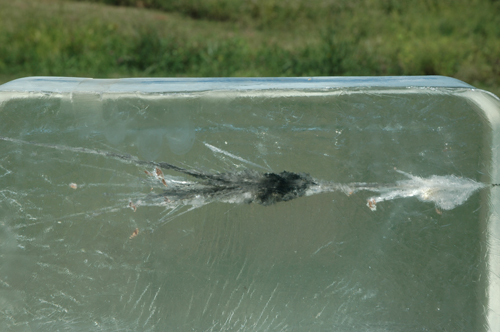At GunDigest, we independently review products. However, we may earn a commission when you purchase through links on our site. Learn More
Big Game Hunting Bullets that Disintegrate?

Percentage of retained weight may appear the reigning measure of expanding bullet performance in game, but the last deer I’ve shot fell to thin-jacketed hunting bullets of ordinary construction. And in Missouri, Dynamic Research Technologies (DRT) is making big game hunting bullets designed to, well, disintegrate into tiny particles.
“We’ve found they kill better than deep-driving softpoints,” says Dustin Worrell, who runs DRT. “In fact, we’ve used them on nilgai.”
Hunting the big, tenacious Indian antelope in Texas, the DRT crew clobbered 11 with 79-grain spitzers from their .223s. Locals, who recommend heavy bullets from .30 magnums, were astonished.
The DRT hunting bullets that put those nilgai on the skids had tungsten cores, Worrell concedes.
He said, “But the tungsten is sintered. It doesn’t stay in one piece. It turns to dust during penetration, just like bullets we make with cores of copper and tin alloys. The tungsten adds weight to bullets of ordinary dimensions. Its particles are heavier too, so drive a bit deeper. But we don’t expect exits. By the time a DRT bullet gets halfway through vitals, it’s pretty much the consistency of powder!”
Such bullets date to the 1990s, when Harold Beal explored frangible metal cores at the Oak Ridge National Laboratory. His goal: deadlier .45 ACP service ammunition.
In 2005, John and Dustin developed machinery to make hunting bullets using Beal’s patents under license. Dustin and company have focused recently on muzzle-loading bullets, which they test on deer on their Missouri whitetail ranch.
His records show deer don’t run as far when struck with DRT hunting bullets as when hit with polymer-tipped hollowpoints. The 170-grain 45-caliber DRT fits an ordinary sabot. A thin (.030) tin cap tops the sintered core at the base of a big nose cavity. Accuracy from a rifle I benched averaged an impressive 2 minutes of angle.
We joined a hunting party headed to the woods with T/C muzzleloading rifles. In three days, we took nine deer with the DRT hunting bullets. I killed a “management buck” and a doe. Hit in the forward ribs, the buck dashed about 30 yards and piled up, dead in mid-stride. The doe lasted a couple of jumps.
“These bullets needn’t plow through the lungs, or even reach them,” said Dustin, as he autopsied a deer on the meat-pole one evening. “We’ve killed deer with .223 bullets that didn’t enter the chest. That burst of energy as the bullet disintegrates imparts shock that ruptures blood vessels in the liver and other vital organs.”
The high velocity of the lightweight .45 DRT bullet no doubt heightens that effect. Have thin-jacketed lead-core bullets of traditional design been too quickly abandoned for hunting bullets that weigh almost as much expended as at the muzzle? Could be.
One of the deadliest deer hunting bullets I’ve ever used is the 165-grain 30-caliber Sierra hollowpoint. It opens violently, but blasts through scapulas.
In elk, it’s better slipped through the ribs than driven to the point of the shoulder. Ditto for softnose classics like Winchester’s Power Point – an overlooked bullet that’s been around since I started hunting 45 years ago. I’ve taken elk with it, handily.
The same goes for Remington’s Core-Lokt. And Hornady and Speer softpoints that get less press than so-called “controlled expansion” bullets.
Honestly, all bullets are designed to expand predictably – that is, in a controlled manner. With materials and engineering, hunting bullet makers manipulate upset. Penetration comes at the expense of wound channel diameter and fast energy release.
Some hunters like exit wounds; I prefer hunting bullets than drives through vitals but balls up just under the off-side hide. For heavy game, I favor softpoints with the moxie to splinter the near shoulder but carry on through the lungs.
I don’t care much how hunting bullets look when I pluck them from an animal, because I’ll not use them again. I do care about the damage inside. Weight retention seems to me over-rated.
The famous Nosler Partition typically loses 40 percent of its weight as the nose breaks apart in tough going. But that shattered nose shreds the vitals as the bullet’s protected heel drives on, commonly exiting.
As the DRT people have found, violence between the ribs is the lethal agent.
Next Step: Get your FREE Printable Target Pack
Enhance your shooting precision with our 62 MOA Targets, perfect for rifles and handguns. Crafted in collaboration with Storm Tactical for accuracy and versatility.
Subscribe to the Gun Digest email newsletter and get your downloadable target pack sent straight to your inbox. Stay updated with the latest firearms info in the industry.